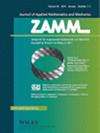Size‐dependent Levinson beam theory for thermal vibration of a nanobeam with deformable boundary conditions
IF 3.2
4区 工程技术
Q1 MATHEMATICS, APPLIED
Zamm-zeitschrift Fur Angewandte Mathematik Und Mechanik
Pub Date : 2023-08-17
DOI:10.1002/zamm.202300336
引用次数: 0
Abstract
In this study, an eigen‐value problem for deformable boundary conditions in nonlocal elasticity is described using Levinson beam theory. Firstly, the nanobeam has been modeled by placing two springs that can be deformed in the downward direction. These springs control the amount of downward displacement at the ends. In the analytical solution, the displacement points are defined by two coefficients and the interior part of the nanobeam deflection is expressed by Fourier sine series. Stokes’ transformation is preferred to enforce the boundary conditions to the desired point. After the mathematical operations, a matrix of coefficients including the general elastic spring constants has been found. The eigenvalues of this coefficient matrix give the frequencies of the Levinson nanobeam. The effect of some parameters on the free vibration frequencies is shown in a series of graphs and tables.具有可变形边界条件的纳米梁热振动的尺寸依赖Levinson梁理论
本文利用Levinson梁理论,讨论了非局部弹性中可变形边界条件的本征值问题。首先,通过放置两个可以向下变形的弹簧来模拟纳米梁。这些弹簧控制着两端向下位移的量。在解析解中,位移点由两个系数定义,纳米梁挠度的内部部分由傅里叶正弦级数表示。最好使用Stokes变换将边界条件强制到所需点。经过数学运算,得到了包含弹性弹簧一般常数的系数矩阵。该系数矩阵的特征值给出了列文森纳米梁的频率。一些参数对自由振动频率的影响用一系列的图表表示出来。
本文章由计算机程序翻译,如有差异,请以英文原文为准。
求助全文
约1分钟内获得全文
求助全文
来源期刊
CiteScore
3.30
自引率
8.70%
发文量
199
审稿时长
3.0 months
期刊介绍:
ZAMM is one of the oldest journals in the field of applied mathematics and mechanics and is read by scientists all over the world. The aim and scope of ZAMM is the publication of new results and review articles and information on applied mathematics (mainly numerical mathematics and various applications of analysis, in particular numerical aspects of differential and integral equations), on the entire field of theoretical and applied mechanics (solid mechanics, fluid mechanics, thermodynamics). ZAMM is also open to essential contributions on mathematics in industrial applications.

 求助内容:
求助内容: 应助结果提醒方式:
应助结果提醒方式:


